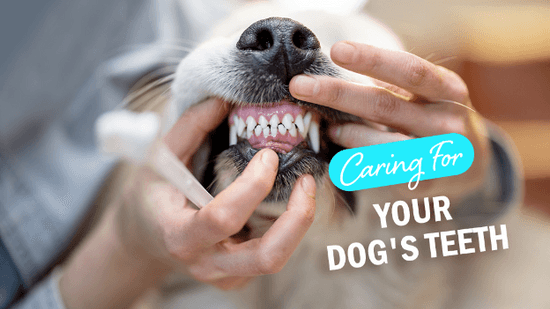Understanding Dental Disease in Dogs
)
As many as 80% of dogs over the age of three are affected by dental disease. This condition can lead to painful complications if left untreated, making it essential to prioritise your dog’s oral health. In this article, we’ll explore common dental issues, their symptoms, and how you can help maintain your dog’s dental health to ensure they stay happy and comfortable.
Common Dental Problems in Dogs
Dental diseases in dogs can vary in severity. Here are some of the most frequent dental conditions that may affect your furry friend:
- Gingivitis and Periodontitis - These are forms of gum disease, with gingivitis being mild and periodontitis causing more severe damage to the teeth and gums.
- Tooth Root Problems - Infection in the tooth's internal structures can result in abscesses or pain.
- Dental Trauma - Chewing on hard objects or accidents can fracture teeth or cause discomfort.
- Plaque and Tartar Buildup - Plaque turns to tartar, causing further decay if not removed.
- Misalignment or Developmental Abnormalities - Misaligned teeth can lead to further complications in your dog’s mouth, such as overcrowding or difficulty eating.
Spotting the Signs of Dental Disease
Dental disease can often go unnoticed, especially in its early stages, as dogs may not show clear signs of discomfort. Here are a few indicators that your dog may be struggling with dental issues:
- Bad breath or foul odour from the mouth
- Discolouration of the teeth, such as yellow or brown stains
- Swollen, bleeding gums
- Difficulty eating or chewing, possibly accompanied by drooling
- Pawing at the mouth or face
- Visible tartar or plaque accumulation
If your dog displays any of these symptoms, it’s crucial to seek veterinary advice as soon as possible to prevent further damage.
Maintaining Your Dog’s Dental Health
Brushing Your Dog’s Teeth
While it might seem challenging at first, brushing your dog’s teeth is an effective way to prevent plaque and tartar buildup. Use toothpaste formulated specifically for dogs and introduce the process slowly. Make it a part of your routine, aiming to brush their teeth at least a few times a week.Chew Toys and Dental Treats
Chewing is a natural action for dogs, and providing them with safe, dental-friendly chew toys can help reduce plaque buildup. Some treats are designed to promote oral health and help clean your dog’s teeth as they chew.Regular Veterinary Check-ups
Dental exams are part of a thorough annual check-up for your dog. During these visits, your vet will check for signs of dental disease and may suggest professional cleanings to remove tartar and plaque that can’t be reached through home care.Dietary Considerations
Your dog’s diet plays an essential role in their dental health. Dry kibble is often a better choice than soft food, as it helps to naturally clean teeth while being chewed. Additionally, avoid feeding your dog sugary treats, which can contribute to plaque buildup.
Professional Dental Care
Sometimes, despite all at-home care, dogs may require professional dental cleaning. This procedure allows your vet to remove stubborn tartar and plaque from below the gumline, where it’s difficult to reach with a toothbrush. In severe cases, dental surgery or extractions may be necessary to relieve pain and prevent further infection.
Prevention is Key
By staying vigilant about your dog’s oral health, you can help prevent painful dental diseases and ensure they maintain a healthy, happy smile for years to come. Regular check-ups, daily brushing, and dental-friendly foods will go a long way in preserving their well-being.
| Tags:DogPet Dental Health |
)
